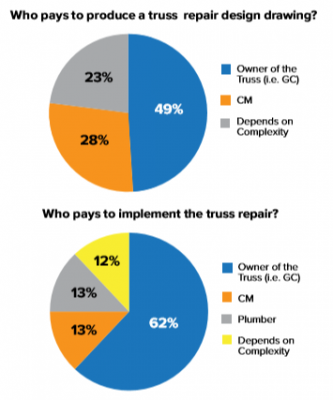Editor's Message: Handling Plumber Damage Repairs
Editor's Message: Handling Plumber Damage Repairs
According to an online survey of component manufacturers (CMs), 96 percent of respondents indicated they have had a plumber damage or modify their products after installation. Of those that had their product damaged, 97 percent indicated their customer asked them for a repair. That overwhelming response indicates this is a common problem. What is interesting is the poll results suggest that CMs do not have a common response to the request for a repair.
Of the types of damage done by plumbers, the most typical damage was to the chords, either in the form of a cut (91 percent) or a hole (89 percent). The next most common damage was to the webs, either with a cut (81 percent) or a hole (68 percent). Disturbingly, 62 percent of respondents indicated that a plumber had cut an entire section out of a component.

Regardless of the actual damage caused by a plumber, a CM’s response to a customer’s repair request varies. In 54 percent of the cases, respondents indicated the owner of the trusses (i.e., the builder, GC, framer, etc.) contractually takes responsibility for the repair and manages the response. In 25 percent of the cases, the CM either creates the repair drawing in house or they work with an outside entity like their design software provider or an engineering firm. Another 13 percent of respondents indicated they immediately send someone out to fix it. The remaining eight percent immediately farm the request out to a truss repair service.
When it comes to paying for the creation of a truss repair drawing, 49 percent indicated the owner of the trusses pays for it. Twenty-eight percent of CMs indicated they cover the cost of the drawing, while another 23 percent indicated it varies widely by job but that most of the time the cost will get passed on to the plumber.
Once the repair drawing is complete, 62 percent of respondents said the owner of the trusses pays for the cost of implementing the repair. Thirteen percent indicated they cover the cost of the repair, another thirteen percent said the plumber covers the cost, and the final 12 percent said it depended on the extent of the repair.
Next month we’ll look at what respondents thought was the primary reason plumbers are damaging installed components and what they are doing to try to address the problem.

